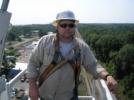radial is a one way feed......if you have a urd fault underground it cant be switched around....so be ready to dig
Results 1 to 10 of 13
Thread: Loop VS Radial feed
-
03-01-2013, 11:45 PM #1
 Junior Member
Junior Member
- Join Date
- Feb 2013
- Posts
- 3
 Loop VS Radial feed
Featured Sponsor
Loop VS Radial feed
Featured SponsorWhat is the difference between a loop feed and a radial feed?
-
03-01-2013, 11:48 PM #2

-
03-02-2013, 02:22 PM #3

As Reppy says. In general electrical terms a radial is one line extending out, while a loop is a line that goes out and comes back to the point it's being fed from. The advantage of the loop is that if a fault occurs you can isolate that section on either side of the fault and everything else stays up. That keeps customers happy and takes the pressure off the repair crew.
Portable defibrillators were first invented to save the lives of linemen. Where's yours?
www.bigclive.com
-
03-03-2013, 12:40 AM #4

Im kinda wondering what others call a 3 way feed on a single phase loop....we call it a (x-y-z) and one thing about them....they are fairly unusual....Ive only seen a few here.....many guys would go crazy trying to figure out a urd switching order with 3 terminal poles involved....but my questions would be if anyone has seen more than 3.....another question is how many times have you used one of those stand-offs with 3 bushings...all 3.....never seen those used too often,I even think many were thrown away.
-
03-03-2013, 06:53 AM #5
 Senior Member
Senior Member
- Join Date
- Feb 2007
- Location
- Ontario Canada
- Posts
- 1,284

Quite common here along with sectionalizers, that is what maps are for.
-
03-03-2013, 09:25 AM #6

Never seen a 3-way URD feed, seen a regular loop or 2-way with a radial pull-off with either a T-splice or transformer mounted 2-bushing insert. I'm guessing on these 3-way feeds that you would have 2 open loop transformers or 2 opens?
-
03-03-2013, 09:42 AM #7
 Senior Member
Senior Member
- Join Date
- Jan 2011
- Location
- conn
- Posts
- 256

Here in CT. they've had what the Co. calls Loop Schemes for 15-20 years, they put a lot of faith in technology and maybe not so much into common sense. Some of the loops tie the same feeder some different feeders, usually 5 reclosers in a typical loop sometimes the engineers get a little fancy and we've had up to 5 reclosers feeding into one piece of wire, it pays to take your time responding to these outage calls just to make sure they've done all their flopping. Usually there are 500 customers between reclosers. We spend a lot of time switching to repair downed conductor going to all the reclosers feeding into the fault and removing taps then going back to ground, tried to get the Co. to make it standard to put disconnect switches on the load side to make this a little quicker and easier but the bean counters said cost to much.
-
03-03-2013, 01:33 PM #8

I'm thinking that we are possibly talking about 2 different things, up North I have heard them speak of loops talking about overhead, down South when we are talking loop we are generally speaking of underground, when I responded to Reppy's post that's what I took it that he was talking about.
-
03-03-2013, 01:59 PM #9
-
03-03-2013, 05:44 PM #10
 Featured Sponsorr
Featured Sponsorrummmm sum of our trunk overhead lines are looped. they have sum kinda smart ocb that can tell where a fault is n opens another ocb on either side of it n then closes a normal open ocb


 Reply With Quote
Reply With Quote




